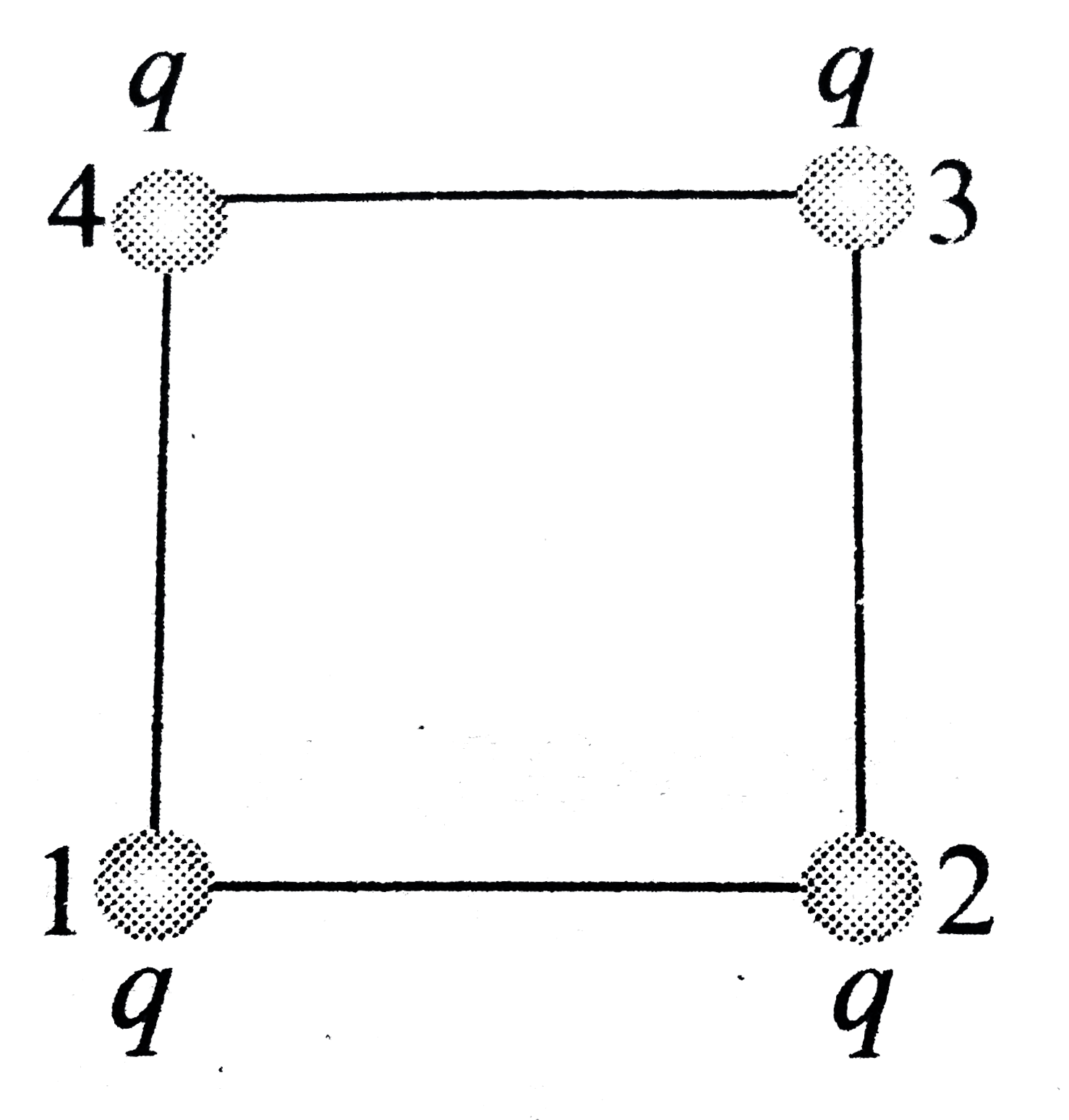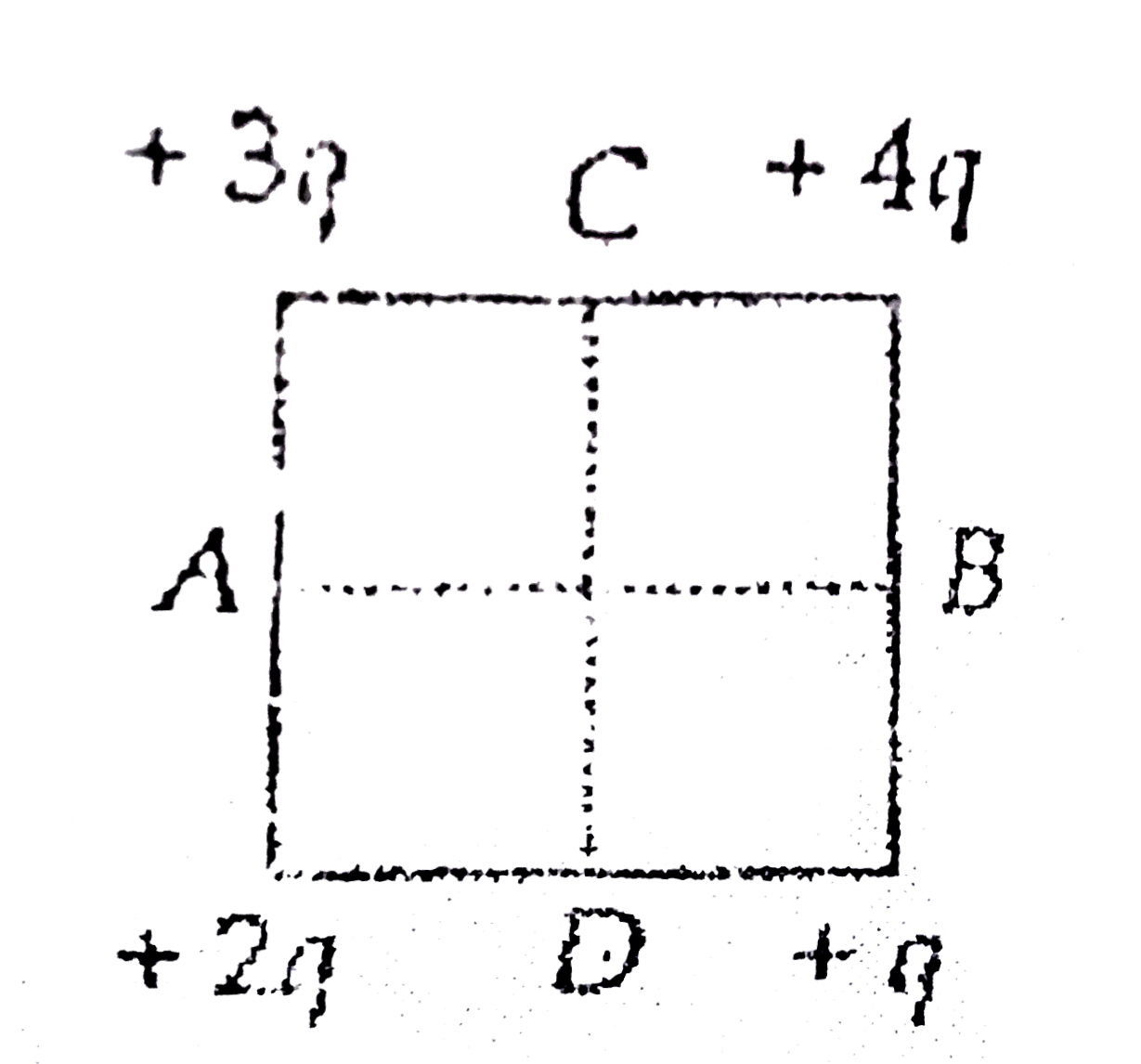Four identical charges Q are fixed at the four corners of a square of side a. The electric field at a point P located symmetrically at a distance a/√2 from the center of the square is
Q2√2πε0a2
Q√2πε0a2
2√2Qπε0a2
√2Qπε0a2
The correct Answer is:B
To solve the problem of finding the electric field at point P due to four identical charges Q fixed at the corners of a square of side a, we can follow these steps:
Step 1: Understand the Geometry
We have four identical charges Q located at the corners of a square. The point P is located symmetrically at a distance of a√2 from the center of the square.
Step 2: Determine the Distance from Each Charge to Point P
The distance from the center of the square to any corner is given by a√2. Since point P is also at a distance of a√2 from the center, we can use the Pythagorean theorem to find the distance from each charge to point P.
The distance from each charge to point P can be calculated as follows:
- The distance from the center of the square to a corner is a√2.
- The distance from the center to point P is also a√2.
- Therefore, the distance from each charge to point P is d=√(a2)2+(a2)2=√a24+a24=√a22=a√2.
Step 3: Calculate the Electric Field Due to One Charge
The electric field E due to a single charge Q at a distance d is given by:
E=14πϵ0⋅Qd2
Substituting d=a√2:
E=14πϵ0⋅Q(a√2)2=14πϵ0⋅Qa22=2Q4πϵ0a2
Step 4: Determine the Direction of the Electric Fields
The electric field vectors due to each charge will point away from the charges (since they are positive). The symmetry of the square means that the horizontal components of the electric fields from opposite charges will cancel out, while the vertical components will add up.
Step 5: Calculate the Net Electric Field
Since there are four charges, and the vertical components of the electric fields will add up, we can express the net electric field Enet as:
Enet=4⋅E⋅cos(θ)
Where θ is the angle between the line connecting the charge and point P, and the vertical line. Given that cos(45∘)=1√2:
Enet=4⋅(2Q4πϵ0a2)⋅1√2=8Q4πϵ0a2√2
Step 6: Final Expression
Thus, the final expression for the electric field at point P is:
Enet=2√2Q4πϵ0a2
We have four identical charges Q located at the corners of a square. The point P is located symmetrically at a distance of a√2 from the center of the square.
The distance from the center of the square to any corner is given by a√2. Since point P is also at a distance of a√2 from the center, we can use the Pythagorean theorem to find the distance from each charge to point P.
- The distance from the center of the square to a corner is a√2.
- The distance from the center to point P is also a√2.
- Therefore, the distance from each charge to point P is d=√(a2)2+(a2)2=√a24+a24=√a22=a√2.
The electric field E due to a single charge Q at a distance d is given by:
E=14πϵ0⋅Qd2
Substituting d=a√2:
E=14πϵ0⋅Q(a√2)2=14πϵ0⋅Qa22=2Q4πϵ0a2
The electric field vectors due to each charge will point away from the charges (since they are positive). The symmetry of the square means that the horizontal components of the electric fields from opposite charges will cancel out, while the vertical components will add up.
Since there are four charges, and the vertical components of the electric fields will add up, we can express the net electric field Enet as:
Enet=4⋅E⋅cos(θ)
Where θ is the angle between the line connecting the charge and point P, and the vertical line. Given that cos(45∘)=1√2:
Enet=4⋅(2Q4πϵ0a2)⋅1√2=8Q4πϵ0a2√2
Thus, the final expression for the electric field at point P is:
Enet=2√2Q4πϵ0a2
Topper's Solved these Questions
- COULOMB LAW AND ELECTRIC FIELDBOOK - CENGAGE PHYSICS ENGLISHCHAPTER - COULOMB LAW AND ELECTRIC FIELDEXERCISE - Multiple Correct
8 Videos
- COULOMB LAW AND ELECTRIC FIELDBOOK - CENGAGE PHYSICS ENGLISHCHAPTER - COULOMB LAW AND ELECTRIC FIELDEXERCISE - Comprehension
25 Videos
- COULOMB LAW AND ELECTRIC FIELDBOOK - CENGAGE PHYSICS ENGLISHCHAPTER - COULOMB LAW AND ELECTRIC FIELDEXERCISE - Subjective
32 Videos
- CENGAGE PHYSICS DPPBOOK - CENGAGE PHYSICS ENGLISHCHAPTER - CENGAGE PHYSICS DPPEXERCISE - subjective type
51 Videos
- ELECTRIC CURRENT & CIRCUITSBOOK - CENGAGE PHYSICS ENGLISHCHAPTER - ELECTRIC CURRENT & CIRCUITSEXERCISE - Kirchhoff s law and simple circuits
15 Videos
Similar Questions
Four identical point charges q are placed at four corners of a square of side a. Find the potential energy of the charge system.
 .
.
View SolutionFour point charges are placed at the corners of a square of side l. Calculate potential at the centre of square.

View SolutionA point charge Q is placed at the corner of a square of side a. Find the flux through the square.
View SolutionFour identical positive point charges Q are fixed at the four corners of a square of side length l. Another charged particle of mass m and charge +q is projected towards centre of square from a large distance along the line perpendicular to plane of square. The minimum value of initial velocity v0 (in m/s) required to cross the square is ?
(m=1gm,l=4√2m,Q=1μc,q=0.5μc)

View SolutionFour identical charges q are placed at the corners of a square of side a. Find the potential energy of one of the charges due to the remaining charges.
 .
.
View SolutionThree charges, each equal to q, are placed at the three. corners of a square of side a . Find the electric field at. the fourth corner.
View SolutionThree charges, each equal to q, are placed at the three. corners of a square of side a . Find the electric field at. the fourth corner.
View SolutionThree charges each of +4μC are the corners B, C, D of a square ABCD of side 1m. The electric field at the centre .O. of the square is
View SolutionFour identical charges each .q. are placed at four corners of a square of side .a.. Find the charge to be placed at the centre of the square so that the system of charges is in equilibrium
View SolutionFour charges are arranged at the corners of a square as shown in the figure. The direction of electric field at the centre of the square is along

View Solution